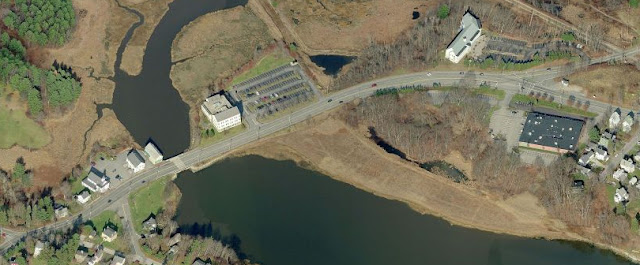Outer Congress Street, between Stevens Avenue and the Stroudwater neighborhood, is a choke point in the city's bicycle and pedestrian network. Aside from long detours through Westbrook or South Portland, it's the only non-freeway connection between Portland and the Jetport area, a district with thousands of jobs and some of the region's biggest employers. It's also a gateway to one of the city's most scenic parks, the Fore River Sanctuary.
Unfortunately, it's been designed to be a dangerous speedway for cars. Large sections of the street don't even have a sidewalk, leaving bus riders to wait in the ditch. The natural surroundings give drivers the impression that they're in the countryside, not in a city, so that many of them hit speeds of 40 to 50 miles an hour along this relatively short stretch:
When I first moved here in 2006, Stroudwater neighborhood residents had prevailed on the city to do a traffic study of outer Congress Street. Unfortunately, the hired engineers took it for granted that moving cars would continue to be the most important role for this public space. They also predicted, wrongly, that traffic would increase considerably. The study recommended only minor changes, and the public that paid for it had little appetite to implement its recommendations.
This year, the Maine DOT is repaving the section of Congress from roughly Stevens Avenue to Johnson Road near UNUM. This presents an opportunity to make some more meaningful improvements, and city staff have revisited the old study to examine where it went wrong, and how its recommendations might be revised to make more meaningful changes for everyone's safety.
It's a good start. But to make more permanent changes, like landscaped medians designed to slow down traffic and give pedestrians a safer place to cross the road, the city will need to spend some of its own money. The capital budget under discussion includes $175,000 line-item to install more traffic calming, better sidewalks and crosswalks, along outer Congress Street. Please write to your city councilors to ask them to support this expenditure (and if you do, please leave a comment with their response —we're trying to keep track of who's on board with this).
Here's an outline of some of the changes being proposed for the short term. You can take a look at maps at the city's website.
- Large sections of Congress Street will be constricted to one inbound lane with a left turn lane and two outbound lanes. This basically formalizes the status quo, where the inbound left lane is usually filled with cars waiting to turn left anyhow...
- ... but it also opens up the opportunity to create new median islands and crosswalks with pedestrian refuges, especially at intersections like Westbrook Street and Frost Street, or close sidewalk gaps, like the one between Stroudwater and Frost Street. It's also bound to help calm down inbound traffic.
- Near the railroad tracks (from near Frost Street to the Italian Heritage Center driveway), the road will narrow to one lane in each direction, with space in the middle for future left-turn lanes and/or landscaped median refuges. Pending the city's budget, this area could be the future location for a nice crosswalk to connect the Portland Trails network across Congress Street; the extra space could also be put to use to widen the sidewalks or provide better bus stops.
"Bikes May Use Full Lane — Change Lanes to Pass" signs (pictured) would be installed at several locations between Johnson Road and Stevens Avenue, giving motorists notice that they should expect bikes in the roadway and giving cyclists an opportunity to question the literacy of the sad, road-ragey motorists who honk at them.
- Inbound cyclists would also gain a climbing bike lane between the Fore River Bridge and Westland. This section has a blind curve, where slow-moving cyclists climbing uphill in the right lane are out of sight of speeding motorists coming up from behind. Even experienced cyclists doing everything right are one texting-and-driving teenager away from a disaster (it's a little better on the other side of the street, heading out of town, and there won't be new bike lanes on that side of the road). Like a truck climbing lane, this bike lane will give slower vehicles a little extra room; hopefully it will be combined with more permanent traffic calming so that the cars move a little slower as well.


 Learn more, and find out where you can purchase a copy.
Learn more, and find out where you can purchase a copy.
No comments:
Post a Comment